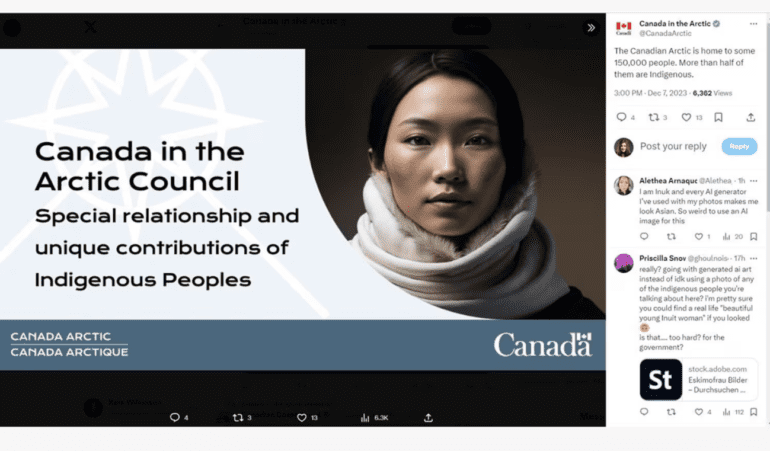TL;DR:
- The Department of Global Affairs issued an apology for using an AI-generated image to represent an Indigenous woman on social media.
- The incident occurred on the Canada in the Arctic Twitter account, which is managed by Canada’s Foreign Affairs Ministry.
- The department deleted the post after concerns were raised about the authenticity of the AI-generated image.
- Global Affairs acknowledged the error and apologized to Inuit and Indigenous communities.
- Alethea Arnaquq-Baril, an Inuk filmmaker, questioned the use of AI for such images and highlighted the challenges of AI technology.
- Nunavut MP Lori Idlout criticized the department’s use of the AI-generated image and called for more Indigenous representation in materials and promotions.
- Inuit Tapiriit Kanatami (ITK) represents Inuit communities across multiple regions in Canada.
- The Canadian government, through Global Affairs, has previously expressed concerns about generative AI’s impact on information integrity.
Main AI News:
In a recent development that underscores the sensitivity of using artificial intelligence in depicting Indigenous individuals, the Department of Global Affairs has extended its deepest regrets to Inuit and Indigenous communities. The apology comes in response to a controversial image posted on social media, generated entirely by artificial intelligence.
The incident occurred on the official Canada in the Arctic Twitter account, managed by Canada’s Foreign Affairs Ministry. Last week, the account released a statement highlighting the fact that more than half of the Canadian Arctic’s 150,000 residents are Indigenous. The statement was accompanied by a graphic featuring an Indigenous woman adorned in fur and a scarf.
Upon scrutiny by The Globe and Mail, concerns arose regarding the authenticity of the image, with some suggesting that it was AI-generated. In response to these inquiries, the department promptly deleted the post and issued an official apology.
Pierre Cugen, spokesperson for Global Affairs, conveyed the department’s remorse, stating, “Global Affairs Canada extends its deepest regrets to the Inuit and Indigenous communities who were misrepresented in this image. This post has been deleted from the account and an apology was issued.”
Global Affairs acknowledged that the image had indeed been created using artificial intelligence, issuing a follow-up statement on Twitter: “An image created by artificial intelligence was wrongly used to represent an Indigenous individual on the @CanadaArctic account. GAC acknowledges this error and apologizes to the Indigenous Peoples who were misrepresented in this image.”
However, the department has not provided immediate clarification regarding the extent to which artificial intelligence is relied upon or whether there are specific guidelines governing its use.
The incident drew the attention of Alethea Arnaquq-Baril, an Inuk filmmaker, who shared her concerns about the use of AI in image generation. She pointed out the quirks of AI technology, remarking, “I am Inuk, and every AI generator I’ve used with my photos makes me look Asian. So weird to use an AI image for this.”
Ms. Arnaquq-Baril suggested that there are plenty of Inuit individuals, even in Ottawa, who would willingly model for such a photo. She highlighted the broader challenges that artists in various fields face when considering the substitution of humans with AI.
Lori Idlout, NDP critic for Indigenous Services, Northern Affairs, and Crown-Indigenous Relations and a Member of Parliament representing Nunavut, expressed her strong disapproval of Global Affairs’ use of the AI-generated image. She emphasized the federal government’s lack of consideration for First Nations, Métis, and Inuit.
In her view, Global Affairs should prioritize hiring more Indigenous individuals for materials and promotional content. She pointed out the rich diversity of Inuit individuals who could have been featured in the social media posting, noting that even the current Governor-General is Inuk.
It’s worth noting that Inuit Tapiriit Kanatami (ITK), a non-profit organization representing Inuit, stated that most Inuit communities are spread across various regions, including the Inuvialuit Settlement Region (Northwest Territories), Nunavut, Nunavik (Northern Quebec), and Nunatsiavut (Northern Labrador). Collectively, these regions constitute Inuit Nunangat, covering 40 percent of Canada’s land area and 72 percent of its coastline.
The Canadian government, through Global Affairs, has previously expressed concerns about generative AI and its potential impact on information integrity. In a joint declaration with 30 other countries, Canada warned about the risk of AI-generated content contributing to misinformation and challenges in identifying accurate information in the online information ecosystem. This concern extends to biased AI-generated media, mass-produced disinformation narratives in multiple languages, and the rise of deepfakes.
Conclusion:
The use of AI-generated images by government departments, as highlighted in this incident, underscores the need for careful consideration of AI’s potential pitfalls, especially in representing diverse communities. To maintain trust and authenticity in the market, organizations should prioritize diverse representation and ethical AI usage in their promotional materials and communications.

